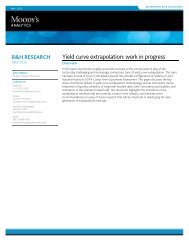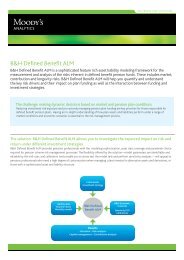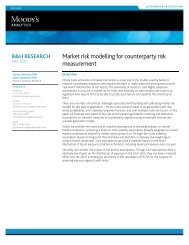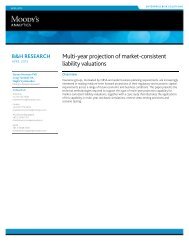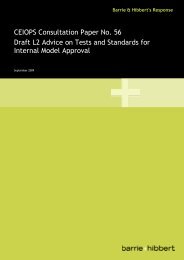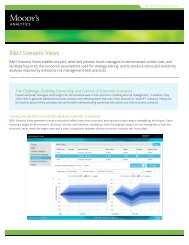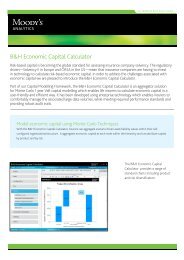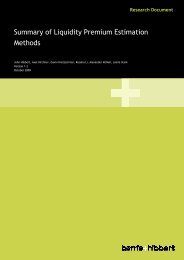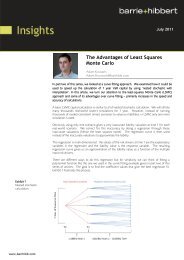A Least Squares Monte Carlo approach to liability ... - Barrie & Hibbert
A Least Squares Monte Carlo approach to liability ... - Barrie & Hibbert
A Least Squares Monte Carlo approach to liability ... - Barrie & Hibbert
You also want an ePaper? Increase the reach of your titles
YUMPU automatically turns print PDFs into web optimized ePapers that Google loves.
A <strong>Least</strong> <strong>Squares</strong> <strong>Monte</strong> <strong>Carlo</strong> Approach <strong>to</strong><br />
Liability Proxy Modelling and Capital<br />
Calculation<br />
<br />
Version 1.0<br />
September 2011<br />
01<br />
Insurance Risk and Capital<br />
www.barrhibb.com Page
Contents<br />
Introduction ...................................................................................................... 3<br />
1 The nested s<strong>to</strong>chastic problem ......................................................................... 4<br />
2 The <strong>Least</strong> <strong>Squares</strong> <strong>Monte</strong> <strong>Carlo</strong> method ............................................................... 6<br />
2.1 Choose risk drivers .............................................................................. 6<br />
2.2 1 year definition ................................................................................. 9<br />
2.3 Creating fitting scenarios ..................................................................... 10<br />
2.4 Fitting <strong>liability</strong> data ............................................................................ 13<br />
2.5 Choice of basis functions ...................................................................... 13<br />
2.6 Validation ........................................................................................ 15<br />
2.7 Finding the real-world distribution of liabilities and calculating capital ............. 15<br />
3 Benefits of the LSMC method ........................................................................... 15<br />
Keywords<br />
<strong>Least</strong> <strong>Squares</strong> <strong>Monte</strong> <strong>Carlo</strong>; proxy model; SCR; capital calculation; regression<br />
www.barrhibb.com Page 2
Introduction<br />
This note outlines a method which can be used for creating a function which approximates a multidimensional<br />
insurance <strong>liability</strong> through the use of <strong>Monte</strong> <strong>Carlo</strong> Simulation and Regression. The process,<br />
model choices, au<strong>to</strong>mation and validation are discussed in detail.<br />
Although a <strong>liability</strong> proxy function has many applications within insurance risk management this note will<br />
discuss use of proxy modelling in the context of a Solvency II 1 year VaR capital calculation.<br />
www.barrhibb.com Page 3
1 The nested s<strong>to</strong>chastic problem<br />
The Solvency II regime advises a 1 year 99.5% VaR of net assets measure of capital. Ideally, the value of net<br />
assets (assets less liabilities) should be read from the full probability distribution as shown in Exhibit 1.<br />
Exhibit 1<br />
Capital read from the full distribution of net assets<br />
The liabilities in this calculation are valued using market consistent principles including the time value of<br />
options and guarantees. We assume in this note that we require a <strong>Monte</strong> <strong>Carlo</strong> simulation <strong>to</strong> value the<br />
liabilities. In order <strong>to</strong> ascertain the full distribution in 1 year for assets and liabilities we are faced with a<br />
nested s<strong>to</strong>chastic problem.<br />
We need <strong>to</strong> perform a 1 year real-world simulation with many thousands of scenarios. Within each of these<br />
scenarios we need <strong>to</strong> perform a risk neutral <strong>Monte</strong> <strong>Carlo</strong> simulation with thousands of scenarios <strong>to</strong> value the<br />
assets and liabilities.<br />
The scenario requirement for such a simulation is therefore in the millions or hundreds of millions.<br />
Exhibit 2<br />
Nested s<strong>to</strong>chastic simulation schematic<br />
Due <strong>to</strong> the runtimes of most insurance asset-<strong>liability</strong> models this is unfeasible with the hardware commonly in<br />
use <strong>to</strong>day.<br />
www.barrhibb.com Page 4
This note outlines a method by which the nested s<strong>to</strong>chastic problem can be solved. It involves the use of a<br />
proxy model which can replace the need <strong>to</strong> revalue the liabilities by <strong>Monte</strong> <strong>Carlo</strong> simulation in each of the<br />
real world scenarios.<br />
In order for this solution <strong>to</strong> be feasible we need the proxy model <strong>to</strong>:<br />
� Give an accurate representation of the liabilities<br />
� Be demonstrably accurate <strong>to</strong> within pre-defined <strong>to</strong>lerances<br />
� Be fast <strong>to</strong> evaluate<br />
� Be easy <strong>to</strong> create and au<strong>to</strong>matable on an ongoing basis<br />
� Include all risks <strong>to</strong> which the liabilities are exposed<br />
The sections below describe how the method can be implemented and how these criteria are met.<br />
www.barrhibb.com Page 5
2 The <strong>Least</strong> <strong>Squares</strong> <strong>Monte</strong> <strong>Carlo</strong> method<br />
The basis for the <strong>liability</strong> proxy method is the <strong>Least</strong> <strong>Squares</strong> <strong>Monte</strong> <strong>Carlo</strong> Method. Several authors 1 have<br />
proposed similar methods in finance, particularly in the field of American option pricing which is an inherently<br />
nested s<strong>to</strong>chastic problem.<br />
In this note we outline a hybrid method, drawing ideas from the LSMC method and curve fitting <strong>approach</strong>es.<br />
The basic idea for insurance capital calculation is that the <strong>liability</strong> value in 1 year’s time can be approximated<br />
by a function found by least squares regression. Once we have a function that approximates the <strong>liability</strong><br />
value we can pass a large number of real-world scenarios through the function <strong>to</strong> calculate a capital<br />
requirement.<br />
The outline of the process for a 1 year 99.5% VaR capital (Solvency II SCR) calculation is shown below:<br />
� Define the form of the true <strong>liability</strong> function<br />
� Choose risk drivers<br />
� Define 1 year time horizon<br />
� Create fitting scenarios<br />
� Choose regression method and basis functions<br />
� Find best sub-set and fit of basis functions<br />
� Validate the fitted function<br />
� Use fitted function with a set of real-world scenarios <strong>to</strong> get the distribution of liabilities and capital<br />
requirement<br />
Although the steps can be reliably au<strong>to</strong>mated within an insurance company reporting process, some choices<br />
are available <strong>to</strong> the modeller and particular care must be taken during the implementation.<br />
The following sections describe each step in more detail.<br />
2.1 Choose risk drivers<br />
We start with the assumption that there exists a true <strong>liability</strong> function that could be valued by <strong>Monte</strong> <strong>Carlo</strong><br />
simulation at all possible points in many dimensions. We also assume for convenience that this <strong>liability</strong><br />
function is continuous 2,3 . We will call this the “true <strong>liability</strong> function” which is unknown.<br />
In the real-world, the <strong>liability</strong> value is a function of a very large number of variables. For example, our<br />
liabilities may be a function of the value of thousands of bond and equity holdings in our portfolio, the health<br />
and longevity prospects of millions of insured lives and many other fac<strong>to</strong>rs. However, for valuation, it is<br />
common <strong>to</strong> apply some reduction in the dimensionality of our risks. We may assume that our liabilities are<br />
well approximated by broad equity and bond indices and a population mortality table. A similar<br />
dimensionality reduction exercise must be undertaken in a capital calculation although the choice of risk<br />
drivers may be different.<br />
1<br />
Tilley, J. A. 1993. Valuing American options in a path simulation model. Transactions of the Society of Actuaries,<br />
Schaumburg 45 499-520.<br />
Carriere, J. F. 1996. Valuation of the early-exercise price for options using simulations and nonparametric regression.<br />
Insurance: Math.E conomics19 19-30<br />
Longstaff, F. A., E. S. Schwartz. 2001. Valuing American options by simulation: A simple least-squares <strong>approach</strong>. Rev.<br />
Financial Stud. 14 113-147.<br />
2<br />
It is important <strong>to</strong> differentiate between the <strong>liability</strong> value function and payoff function. For example, a digital option has<br />
a discontinuous, stepped payoff function but a continuous value function. Almost all liabilities we would encounter in<br />
practice will have a continuous <strong>liability</strong> value.<br />
3<br />
More formally, we require that the payoff function is square-integrable which is a very general requirement and should<br />
be easily achieved.<br />
www.barrhibb.com Page 6
The choice of risk drivers is an exercise in parsimony: we must find a small 4 number of variables that<br />
adequately explain the risk characteristics of our liabilities.<br />
We should be able <strong>to</strong> write down explicitly the arguments of the true <strong>liability</strong> function we are trying <strong>to</strong><br />
approximate. For example:<br />
For each source of risk, we must specify the number of fac<strong>to</strong>rs that describe the risk and the form of the<br />
fac<strong>to</strong>rs. Some examples of choices that may be made for common risk types are described below:<br />
2.1.1 Equity risk<br />
In a capital calculation, it is common <strong>to</strong> use only a small number of risk drivers <strong>to</strong> explain the variation on the<br />
value of equities. For most purposes one will suffice. This may be the value of all equity holdings in one<br />
year’s time or equivalently, the percentage change over the year.<br />
In cases where it is important within a portfolio <strong>to</strong> differentiate between different classes of equity (for<br />
example local and foreign holdings) a more detailed model may be used by adding more fac<strong>to</strong>rs. However,<br />
it is often possible <strong>to</strong> have a richer equity return model (both for the 1 year real-world and multi-year risk<br />
neutral model) while still using only a single equity risk fac<strong>to</strong>r representing the <strong>to</strong>tal holding value <strong>to</strong> describe<br />
the <strong>liability</strong> function.<br />
Equity dimensionality reduction example:<br />
Suppose we make a guarantee <strong>to</strong> policyholders on a pool of equity assets which contain five<br />
different underlying countries’ equity index holdings and four currency exposures.<br />
In a nested s<strong>to</strong>chastic model we project the real-world value of these nine variables over year 1 and<br />
calculate the value of our <strong>to</strong>tal equity holding. We perform some rebalancing of the equity<br />
portfolio and continue the projection of the assets using the full 9 risk fac<strong>to</strong>rs in our risk neutral<br />
model.<br />
Although there are nine distinct risk drivers at work, we may significantly reduce the dimensionality<br />
of the <strong>liability</strong> function by thinking carefully about the rebalancing dynamics.<br />
Three different methods are described below:<br />
1) We assume that the equity portfolio is always rebalanced <strong>to</strong> the same portfolio mix. In this<br />
case the only risk driver necessary for the <strong>liability</strong> function is the value of the portfolio at<br />
the end of the year without any approximation or loss of accuracy.<br />
2) We assume that we cut our holding of foreign equity <strong>to</strong> reduce risk after an equity fall<br />
irrespective of which equity assets have lost money. In this case, again a single variable<br />
for the value of the <strong>to</strong>tal equity holdings is sufficient for the <strong>liability</strong> value function.<br />
3) We assume that we cut the holding of foreign equity in response <strong>to</strong> their relative<br />
underperformance. In this case, we would need <strong>to</strong> split the equity portfolio value in<strong>to</strong><br />
local and overseas components. This still significantly reduces the dimensionality of the<br />
<strong>liability</strong> function nine variables <strong>to</strong> two and accurately retains the dynamics of the nested<br />
s<strong>to</strong>chastic calculation.<br />
4 Small here is relative. The smaller the number of risk drivers the faster ALM runtimes will be. As a rule of thumb, less<br />
than 10 risk drivers for any particular <strong>liability</strong> portfolio is a good objective although this is dependent on specific features<br />
of the liabilities and appetite for ALM runtimes.<br />
www.barrhibb.com Page 7
2.1.2 Interest rate risk<br />
Insurances liabilities are sensitive <strong>to</strong> changes in any point on the risk free yield curve. We may say that each<br />
forward rate represents an individual risk driver – giving 100 or more potential interest rate risk drivers.<br />
However, this level of granularity adds very little <strong>to</strong> a <strong>liability</strong> valuation or capital calculation.<br />
In practice, when performing a <strong>Monte</strong> <strong>Carlo</strong> valuation we model the movements of the entire yield using a<br />
small number of underlying s<strong>to</strong>chastic fac<strong>to</strong>rs. A similar reduction in the dimensionality of the yield curve is<br />
necessary for both the 1 year real-world model and the <strong>liability</strong> function.<br />
There are a number of possible ways <strong>to</strong> achieve this dimensionality reduction. For example we may use a two<br />
fac<strong>to</strong>r short rate model <strong>to</strong> simulate possible real-world yield curves over the first year. The mechanics of this<br />
model mean that changes in two underlying risk fac<strong>to</strong>rs generate changes in the entire terms structure over<br />
the year. In this framework, it is convenient <strong>to</strong> use the same two underlying risk fac<strong>to</strong>rs as arguments for the<br />
<strong>liability</strong> function. Following this method will mean that we have a direct unambiguous mapping of interest<br />
rate risk, avoid translating real-world yield curves back in<strong>to</strong> new fac<strong>to</strong>rs for use in the <strong>liability</strong> function and do<br />
not lose any accuracy in the <strong>liability</strong> function specification.<br />
This method of using common underlying fac<strong>to</strong>rs in the real world simulation and <strong>liability</strong> function applies <strong>to</strong><br />
other forms of interest rate risk model <strong>to</strong>o.<br />
Other common methods of modelling the real-world change in interest rates over the first year are Libor<br />
Market Model and Principal Component Analysis style methods. In both of these cases we isolate a small<br />
number of fac<strong>to</strong>rs that describe changes in term structures over the year. Just like with short rate models, it<br />
is convenient and efficient <strong>to</strong> use the underlying fac<strong>to</strong>rs of the model as arguments in the <strong>liability</strong> function.<br />
Number of interest rate fac<strong>to</strong>rs required?<br />
A common question is “how many fac<strong>to</strong>rs are required in an interest rate model <strong>to</strong> adequately<br />
assess risk in a capital calculation?”<br />
Results of principal component analysis on his<strong>to</strong>ric data usually conclude that most of the changes<br />
in the yield curve can be described in terms of two or three fac<strong>to</strong>rs (often called shift, twist and<br />
curvature).<br />
Importantly, this analysis applies <strong>to</strong> changes in the yield curve rather than <strong>to</strong> changes in <strong>liability</strong><br />
values. The number of fac<strong>to</strong>rs necessary <strong>to</strong> describe the risk in a <strong>liability</strong> portfolio requires specific<br />
analysis and judgement.<br />
For example, if our portfolio contains a fairly simple duration mismatch between assets and<br />
liabilities a single, prudently calibrated risk fac<strong>to</strong>r may suffice for the purposes of capital calculation.<br />
However, a portfolio with more complex holdings and derivative overlays may be insensitive <strong>to</strong><br />
simple up or down movements in the yield curve but have large geared risk exposures <strong>to</strong><br />
multifarious movements in yield curves.<br />
2.1.3 Volatilities<br />
In most cases where <strong>Monte</strong> <strong>Carlo</strong> models are employed liabilities values are highly sensitive <strong>to</strong> marketimplied<br />
volatility. If this is the case we may also want <strong>to</strong> build implied volatility fac<strong>to</strong>rs in<strong>to</strong> our <strong>liability</strong><br />
function.<br />
Risk fac<strong>to</strong>r identification here follows a similar reasoning <strong>to</strong> interest rates. Although implied volatility has<br />
many dimensions and complexities, we summarize the risk <strong>to</strong> our liabilities in a small number of fac<strong>to</strong>rs.<br />
It makes most sense <strong>to</strong> use the s<strong>to</strong>chastic fac<strong>to</strong>rs and / or parameters of our risk neutral models as the<br />
arguments for our <strong>liability</strong> function.<br />
If a s<strong>to</strong>chastic volatility model is used such as the <strong>Barrie</strong> & <strong>Hibbert</strong> SVJD model 5 , we have a natural method of<br />
stressing implied volatility. For example in this model we have a coupled s<strong>to</strong>chastic system, where we have<br />
modelled both the asset price process , and the variance value process , such that:<br />
5 <strong>Barrie</strong> & <strong>Hibbert</strong> Note: S<strong>to</strong>chastic Volatility Jump Diffusion Calibration, Dynamics & Implementation; Lawson 2008<br />
www.barrhibb.com Page 8
The single risk driver evolves s<strong>to</strong>chastically and leads <strong>to</strong> a change in the entire volatility surface. This is a<br />
natural choice as the driver of equity-implied volatility risk in the <strong>liability</strong> formula because the model can be<br />
used in both real-world and risk neutral modes 6 .<br />
For deterministic volatility models such as the constant volatility model underlying the Black-Scholes formula,<br />
it is still possible <strong>to</strong> include implied volatility risk in the <strong>liability</strong> function. In this case we simply choose the<br />
fixed parameter as the volatility argument in our <strong>liability</strong> formula. If we include implied volatility in this way<br />
then we must also specify some consistent method of generating a distribution of implied volatility in the realworld.<br />
Simply adding an external correlated risk fac<strong>to</strong>r <strong>to</strong> a set of constant volatility real-world simulations<br />
(although not theoretically correct as in Hes<strong>to</strong>n model above) is a simple, robust method of including this<br />
source of risk in a capital calculation framework for most <strong>liability</strong> types.<br />
Other methods may involve the use of both s<strong>to</strong>chastic and fixed parameters in the s<strong>to</strong>chastic volatility<br />
framework. For example, <strong>to</strong> generate broadly parallel shifts in the volatility surface using the Hes<strong>to</strong>n model<br />
we need <strong>to</strong> stress both the initial value of the s<strong>to</strong>chastic volatility level and its mean reversion level .<br />
Similar considerations are required for interest rate implied volatility and other economic risks like credit<br />
spreads etc<br />
2.1.4 Non-market risks<br />
In addition <strong>to</strong> market risk fac<strong>to</strong>rs, insurance portfolios often have a number of non-market risk fac<strong>to</strong>rs that<br />
affect the change in <strong>liability</strong> value over the year. For example, assumed mortality rates, assumed lapse rates<br />
and assumed take-up rates of policy options are all subject <strong>to</strong> uncertain change over the year and can have<br />
large effects on <strong>liability</strong> value and capital.<br />
For these risk fac<strong>to</strong>rs, we should use the same process, choosing a small number of risk fac<strong>to</strong>rs that describe<br />
the dynamic of the portfolio. For example, we may apply a “percentage of table” scaling fac<strong>to</strong>r <strong>to</strong> the<br />
mortality rates (qx) <strong>to</strong> describe broadly the changes in actuarial assumptions over the year.<br />
Once we have chosen the set of risk fac<strong>to</strong>rs that describe our liabilities, we need <strong>to</strong> choose our definition of<br />
the 1 year interval.<br />
2.2 1 year definition<br />
It is important <strong>to</strong> define exactly what we mean by 1 year.<br />
The theoretically correct 1 year VaR capital is the amount of money required <strong>to</strong>day so that we can be sure <strong>to</strong><br />
be solvent in 1 year’s time, including the effect of all events that take place over the year: Our liabilities will<br />
reduce in duration; our assets and liabilities will have cash flows in and out; and changes in their composition;<br />
economic variables in the market will have experienced a full year of market risk and assumptions about noneconomic<br />
risks such as mortality will evolve.<br />
However due <strong>to</strong> the complexity of rolling forward ALM models for a 1 year time frame or for theoretical or<br />
internal consistency reasons, many insurance companies prefer <strong>to</strong> use a “Time 0 <strong>liability</strong>” <strong>approach</strong>. Here we<br />
assume that economic variables undergo a full year of market risk while “<strong>liability</strong> time” does not advance.<br />
This is the <strong>approach</strong> employed in the Solvency II standard formula.<br />
6 B&H Note: 1-year real-world projection of equity implied volatility; Modelling and calibration methodology; Morrison<br />
2011<br />
www.barrhibb.com Page 9
There are many fine points which need <strong>to</strong> be considered under either of the <strong>liability</strong> time definitions, in<br />
particular, cash flows, rebalancing and management actions.<br />
The important point <strong>to</strong> note here is that either of the time 1 or time 0 <strong>liability</strong> definitions can be used in the<br />
nested s<strong>to</strong>chastic model which we will create the regression based fitting process <strong>to</strong> mirror.<br />
The following charts illustrate the difference between the methodologies in a full nested s<strong>to</strong>chastic<br />
calculation:<br />
Exhibit 3<br />
Nested s<strong>to</strong>chastic simulation. Time1 <strong>approach</strong> (left) and time 0 <strong>approach</strong> (right).<br />
Other methods may be <strong>to</strong> stress all assets and liabilities over the first month or other time step or <strong>to</strong> employ a<br />
hybrid model where some variables like asset values are updated at time 0 whereas others like accounting<br />
variables are updated only at time 1.<br />
Once we have decided the form and timing of the true <strong>liability</strong> function we begin the work of finding an<br />
approximation <strong>to</strong> it. The first step is <strong>to</strong> create a set of fitting scenarios.<br />
2.3 Creating fitting scenarios<br />
Fitting scenarios are used <strong>to</strong> create approximate <strong>liability</strong> valuations which will be used in fitting the proxy<br />
formula <strong>to</strong> the true <strong>liability</strong> value.<br />
In creating fitting scenarios, we need first need <strong>to</strong> choose a multi-dimensional range over which we would<br />
like <strong>to</strong> approximate the true <strong>liability</strong> function. For each of the identified risk drivers we choose a range that<br />
contains all likely <strong>liability</strong> scenarios plus some extra allowance for what-if scenarios.<br />
For example if we think the 99.5% worst case equity fall is 40% for a capital calculation we may want <strong>to</strong> fit the<br />
function <strong>to</strong> cover a 50% or 60% fall in equities for some safety. Further if we would also like <strong>to</strong> be able <strong>to</strong><br />
estimate an updated capital requirement after a 99.5% event then we should try <strong>to</strong> fit our function <strong>to</strong> include<br />
at least a 64% fall in equities (40% capital after a 40% fall) or up <strong>to</strong> an 80% fall or more for safety.<br />
An example multi-dimensional fitting range is shown below:<br />
Exhibit 4<br />
Example fitting range specification<br />
Variable Min Max Initial Value<br />
Equity Value 0.1 3 1<br />
Credit Spread 1% 20% 4%<br />
Interest Rate Fac<strong>to</strong>r 1 Stress<br />
(Standard Deviations)<br />
-6 6 0<br />
…..<br />
www.barrhibb.com Page 10
Having chosen the fitting range, we create asset of 1year, random 7 , multi-dimensional, uniform fitting<br />
scenarios. Each scenario contains a random change <strong>to</strong> the value of each of the chosen <strong>liability</strong> risk drivers<br />
over a 1 year term. We create a large number of these stressed positions. The more stresses we create, the<br />
more accurate our fitting will be. We call these “fitting outer scenarios”.<br />
Exhibit 5<br />
Fitting outer scenarios in two dimensions<br />
The use of fitting scenarios in this manner (proposed 8 as an improvement <strong>to</strong> the Longstaff & Schwartz<br />
<strong>approach</strong>) allows us <strong>to</strong> fit over the entire range of interest with evenly distributed fitting scenarios. By<br />
contrast, a more traditional application 9 of the least squares <strong>Monte</strong> <strong>Carlo</strong> technique would be based on a set<br />
of traditional nested s<strong>to</strong>chastic scenarios (differing only by the small number of inner scenarios employed).<br />
Under this method our outer fitting scenarios would be the 1 year real-world paths. This method is much<br />
slower <strong>to</strong> converge in a capital calculation because of the relatively small number of fitting points in the tails of<br />
the distribution which are of most importance for a capital calculation. It also gives us no knowledge of the<br />
behaviour of the liabilities in un-sampled areas of the range of interest.<br />
Exhibit 6<br />
Real-world 1 year scenarios in two dimensions<br />
7 In fact, low discrepancy quasi-random numbers work better than pseudo random numbers for the fitting scenarios<br />
leading <strong>to</strong> faster convergence and improved stability of the algorithm and are easy <strong>to</strong> apply in practice.<br />
8 N. Søndergaard Rasmussen (November 2002), Improving the least-square <strong>Monte</strong>-<strong>Carlo</strong> <strong>approach</strong>.<br />
9 <strong>Barrie</strong> & <strong>Hibbert</strong> Note: Variable annuity economic capital: the least-squares <strong>Monte</strong> <strong>Carlo</strong> <strong>approach</strong>; Cathcart & Morrison<br />
www.barrhibb.com Page 11
Once we have created these stressed fitting positions, we re-calibrate our risk neutral economic scenario<br />
genera<strong>to</strong>r using the stressed risk drivers, for example, using a new initial yield curve, equity value, volatility<br />
calibration etc. We then run a small number of random scenarios of our risk neutral economic scenario<br />
genera<strong>to</strong>r for each of the fitting positions. We call these “fitting inner scenarios”. Typically for a fixed<br />
scenario budget we aim <strong>to</strong> run a very large number of outer scenarios and a very small number of inner<br />
scenarios. The number of inner scenarios may be as low as 1 per outer scenario and must be independent of<br />
each other. Typical run sizes are in the region of 10,000 (outer) sets of two (inner) scenarios making 20,000<br />
<strong>to</strong>tal ALM scenarios required. The rational for using two inner scenarios is that by using the antithetic<br />
sampling variance reduction technique we can have a relatively large reduction in the variability of the<br />
inaccurate valuations and therefore in the subsequent fitting.<br />
Visualize the fitting scenarios required <strong>to</strong> run a 4 year projection in Exhibit 1.<br />
Exhibit 7<br />
Example fitting scenarios with two risk drivers over a 4 year <strong>liability</strong> term<br />
Inner and Outer fitting scenarios using time 1 definition (left) and time 0 definition (right)<br />
Fitting outer scenarios in green, fitting inner (risk neutral) scenarios in blue with 1 inner per outer scenario<br />
Process manger software and the <strong>Barrie</strong> & <strong>Hibbert</strong> ESG API may be used <strong>to</strong> generate the fitting scenarios for<br />
this task in an au<strong>to</strong>mated robust manner. These sets of scenarios will be combined in a small number of<br />
grouped files for a bulk ALM model run.<br />
Non-economic scenarios are added in a similar way. These may be s<strong>to</strong>chastic over the first time step and<br />
deterministic thereafter or s<strong>to</strong>chastic in both.<br />
Once these fitting economic scenarios are run they must be run through the ALM software and the value of<br />
liabilities determined. In particular, for each outer fitting simulation, we must retrieve from the ALM model<br />
the average of the discounted <strong>liability</strong> values over all inner simulations. We discount <strong>to</strong> time 0 or time 1<br />
depending on our definition of our 1 year time horizon specified earlier.<br />
After completing this process, we should have a large number of inaccurate <strong>liability</strong> valuations (equal in<br />
number <strong>to</strong> the number of fitting outer scenarios). These valuations are correct on average but each one is<br />
inaccurate due <strong>to</strong> a large amount of random sampling error caused by the small number of inner simulations<br />
used. This effect can be seen when the inaccurate <strong>liability</strong> valuations are plotted against the risk drivers that<br />
generated them. An example for a European put option with one source of risk (equity value) is shown in<br />
Exhibit 8.<br />
www.barrhibb.com Page 12
Exhibit 8<br />
Results of fitting scenarios – inaccurate European put option valuations.<br />
2000 outer scenarios with two antithetic inner scenarios each (4000 ALM scenarios <strong>to</strong>tal).<br />
As we expect, the valuations are very inaccurate due <strong>to</strong> random error and at low equity values the valuations<br />
are usually higher and vice versa. We will see later how these are used <strong>to</strong> approximate the <strong>liability</strong> function.<br />
An important consideration in generating these fitting scenarios is our exact definition of the <strong>liability</strong> and how<br />
we can aggregate different <strong>liability</strong> components.<br />
2.4 Fitting <strong>liability</strong> data<br />
To this point we have assumed that we are performing the exercise on a single <strong>liability</strong> book where we<br />
require a single <strong>liability</strong> value <strong>to</strong> be returned. In practice, a capital calculation must usually be undertaken on<br />
multiple <strong>liability</strong> books simultaneously and each book may have multiple components which comprise the net<br />
<strong>liability</strong> value.<br />
If this is the case, we may wish <strong>to</strong> identify additive sub-components of the <strong>to</strong>tal <strong>liability</strong> and fit each<br />
individually. For example, an insurance portfolio may comprise a <strong>liability</strong> due <strong>to</strong> living benefits and one due<br />
<strong>to</strong> death benefits. We may further wish <strong>to</strong> add this portfolio <strong>to</strong> the value of with profits portfolio in the same<br />
organization. As long as we would simply add the individual components in a nested s<strong>to</strong>chastic calculation, it<br />
is possible <strong>to</strong> fit a <strong>liability</strong> function for each one individually and create a <strong>to</strong>tal <strong>liability</strong> function by adding the<br />
individual functions. Alternatively, we may prefer <strong>to</strong> add the <strong>liability</strong> values in the scenarios first and fit a<br />
single <strong>liability</strong> function at the end.<br />
Having access <strong>to</strong> more granular functions is beneficial for analysing and decomposing the components risk<br />
and capital. Doing this will also permit more advanced modelling of organizational structure and capital flows<br />
etc.<br />
2.5 Choice of basis functions<br />
Once we have our fitting data we can begin the fitting process. We will approximate the <strong>liability</strong> function by<br />
performing a regression through our inaccurate valuations.<br />
A large body of statistical literature has built up over many years which describe various regression<br />
methodologies. We will describe just one of many possible methods in this note – polynomial regression.<br />
We choose our regression basis functions <strong>to</strong> be a set of polynomial terms up <strong>to</strong> a pre-specified order in each<br />
of the risk drivers and their cross terms.<br />
For example, in 2 risk dimensions a polynomial of degree 3 which may describe the liabilities is:<br />
www.barrhibb.com Page 13
Where L is the <strong>liability</strong> value, R1 and R2 are risk drivers and a1 <strong>to</strong> a9 are coefficients <strong>to</strong> be estimated.<br />
We then perform an ordinary least squares regression of the inaccurate <strong>liability</strong> valuations on the basis<br />
functions. The regression coefficients calibrate the <strong>liability</strong> proxy function <strong>to</strong> the true <strong>liability</strong> function by<br />
smoothing through the random errors in the inaccurate <strong>liability</strong> valuations.<br />
This is shown for the European put option example in Exhibit 9.<br />
Exhibit 9<br />
Regression fit of degree 4 polynomial <strong>to</strong> European put option<br />
In fact, instead of ordinary polynomials, we use Legendre polynomials for the fitting. This class of function is<br />
beneficial for their orthogonal properties which promote numerical stability.<br />
Polynomial functions are a very flexible <strong>to</strong>ol for fitting many different types of curves and have performed<br />
well empirically on many <strong>liability</strong> types and in high risk dimensions.<br />
Although the fitting is subject <strong>to</strong> a degree of sampling error from the randomness of the fitting scenarios, its<br />
convergence has been formally proved 10 . As we add more scenarios and basis functions we are guaranteed<br />
<strong>to</strong> converge <strong>to</strong> the true <strong>liability</strong> function 11 . In practice, the rate of convergence is dependent on the number<br />
of risk dimensions used, the variability of the inaccurate <strong>liability</strong> estimates and the smoothness and<br />
differentiability of the true <strong>liability</strong> function we are trying <strong>to</strong> approximate.<br />
Techniques also exist <strong>to</strong> estimate the potential sampling error in a fitted function and therefore calculate the<br />
potential impact on estimated capital required and increase the number of scenarios used if needed.<br />
A drawback of the polynomial regression technique is the large number of potential terms in the basis<br />
function. For even moderate numbers of risk drivers this can quickly increase in<strong>to</strong> the thousands and may be<br />
greater than the number of fitting scenarios. In this case, a method is needed <strong>to</strong> select a subset of the<br />
polynomial terms that describes the <strong>liability</strong> function well without over fitting <strong>to</strong> the random <strong>liability</strong><br />
valuations. The Akaike Information Criterion 12 is a robust statistical test for this use. It compares competing<br />
sub-models, rewarding terms which increase descriptive power and penalizing the inclusion of terms which<br />
do not.<br />
10<br />
L. Sten<strong>to</strong>ft, Convergence of the <strong>Least</strong> <strong>Squares</strong> <strong>Monte</strong> <strong>Carlo</strong> Approach <strong>to</strong> American Option Valuation, Management<br />
Science, Vol. 50, No. 9 (Sep., 2004),<br />
11<br />
Assuming some very general preconditions are met for the <strong>liability</strong> payoffs<br />
12<br />
Akaike, Hirotugu (1974), A new look at the statistical model identification. IEEE Transactions on Au<strong>to</strong>matic Control 19<br />
(6)<br />
www.barrhibb.com Page 14
In this way a variable selection algorithm such as a stepwise procedure or other method can be implemented<br />
which selects a parsimonious subset of terms for use in the regression. This allows us <strong>to</strong> use a fully<br />
au<strong>to</strong>mated process <strong>to</strong> generate the <strong>liability</strong> function which does not require excessive human intervention or<br />
judgement.<br />
2.6 Validation<br />
There are two main methods b y which the fitted function may be validated.<br />
The first involves <strong>Monte</strong> <strong>Carlo</strong> valuation of the true <strong>liability</strong> value at a number of important points. For<br />
example, we may choose a small number of stressed values at which we wish <strong>to</strong> validate the function. We<br />
can then run a large number of risk neutral (inner) simulations through the ALM model <strong>to</strong> more accurately<br />
value the liabilities. If these valuations agree (within some error bands) <strong>to</strong> the value predicted by the <strong>liability</strong><br />
function then we can be fairly certain that our function will be universally accurate. The more points we use<br />
and the better we select these points, the more certain we can become.<br />
The second method is <strong>to</strong> estimate standard errors bars around the fitted function. To do this we can use a<br />
“bootstrapping” technique. By re-fitting the <strong>liability</strong> function many times using sub-sets of the original data,<br />
we create a set of <strong>liability</strong> function estimates that create a confidence band around the original fit. We can<br />
calculate our capital using each of the sub-set fits which will give us an estimate of the potential standard<br />
error of the calculated capital. As an alternative <strong>to</strong> bootstrapping, we may use repeated random LSMC runs<br />
with new fitting scenarios. Although this <strong>approach</strong> takes longer <strong>to</strong> run, the sampling error characteristics of<br />
the liabilities should not change significantly from one valuation period <strong>to</strong> the next (if the same model and<br />
fitting range are used). We should therefore be able <strong>to</strong> conduct a formal fitting error experiment very<br />
infrequently (say once a year in a quiet modelling period) and use this <strong>to</strong> inform the formal reporting results,<br />
2.7 Finding the real-world distribution of liabilities and calculating capital<br />
Once we have validated the <strong>liability</strong> function, we can calculate our capital by passing a set of real-world risk<br />
driver values through the <strong>liability</strong> function. This produces a full distribution of possible <strong>liability</strong> values from<br />
which the VaR can be read. Typically a large number of real-world scenarios should be used for a VaR<br />
calculation <strong>to</strong> eliminate sampling error in the tail of the distribution.<br />
3 Benefits of the LSMC method<br />
We have seen above the process by which a least squares <strong>Monte</strong> <strong>Carlo</strong> proxy model can be created and<br />
used. We summarize the benefits below:<br />
� The method uses relatively few scenarios (in the region of 20,000 compared <strong>to</strong> the many millions<br />
required for a full nested s<strong>to</strong>chastic calculation)<br />
� The method has a formal mathematical basis for convergence<br />
� The choice of fitting points is done methodically and does not use human intuition or require us <strong>to</strong><br />
trade off accuracy in different regions of the fit<br />
� The choice of basis functions and fitting of the function can be completely au<strong>to</strong>mated<br />
� Polynomial function are very flexible and able <strong>to</strong> fit <strong>to</strong> very efficiently <strong>to</strong> many different function<br />
shapes<br />
� The fitting is very fast <strong>to</strong> perform (generally a few minutes <strong>to</strong> one hour for most practical<br />
applications)<br />
� Evaluation of the proxy function is extremely fast<br />
� All market and non-market risks and their joint behaviour can be modelled<br />
� A confidence interval for the <strong>liability</strong> function and capital requirement can be estimated<br />
� The proxy function and method for fitting and confidence can be easily explained <strong>to</strong> senior<br />
management and used within other parts of the business such as asset allocation, hedging etc<br />
� The technique allows us <strong>to</strong> use a very large number of real-world simulations in the capital<br />
calculation, eliminating sampling error in the tail of the real-world distribution<br />
www.barrhibb.com Page 15
Given these benefits, we believe that the method outlined above is a robust accurate technique for<br />
calculating and reporting a capital requirement.<br />
4 Case study<br />
The following charts show the results of a case study on a full ALM model conducted in conjunction with a<br />
large European insurer. The case study constructs a <strong>liability</strong> function by regression <strong>to</strong> approximate the value<br />
of a with profits <strong>liability</strong> portfolio.<br />
The fitting is performed in 8 risk dimensions: two interest rate fac<strong>to</strong>rs, interest rate volatility, equity value,<br />
equity volatility, credit spreads, lapse rates and mortality rates.<br />
The fitting uses 20,000 <strong>to</strong>tal ALM scenarios for the fitting. The charts below show a validation of the fit,<br />
comparing the <strong>liability</strong> proxy function <strong>to</strong> more accurate <strong>Monte</strong> <strong>Carlo</strong> valuations using 1000 scenarios each.<br />
Exhibit 10<br />
Validation of <strong>liability</strong> function<br />
www.barrhibb.com Page 16
As well as validating well in each individual dimension, we test how well the function predicts changes in<br />
simultaneous dimensions.<br />
Exhibit 11<br />
Validation of a number of joint stresses<br />
We can see here that the function is an accurate description of the liabilities for stresses where multiple risk<br />
drivers are altered as well as for the single risk case.<br />
By plotting the function in joint dimensions, we can gain insight in<strong>to</strong> the joint behaviour of our liabilities.<br />
Exhibit 12 shows how our liabilities react <strong>to</strong> simultaneous changes in interest rates and lapse rates.<br />
www.barrhibb.com Page 17
Exhibit 12<br />
Liability function in 2 (of 8) dimensions<br />
In this case an asset duration shorter than the liabilities causes a negative exposure <strong>to</strong> interest rate falls (at<br />
current lapse rates). We can see that when lapse rates are very low, we have a much higher exposure <strong>to</strong><br />
interest rates. While for very high lapse rates our exposure <strong>to</strong> interest rate changes is very small. This makes<br />
sense – when many people lapse, our <strong>liability</strong> dutration decreases so our assets are much better matched.<br />
While the reverse is true when lapse rates fall.<br />
5 Control variates and replicating portfolios<br />
It is also possible <strong>to</strong> combine the LSMC technique with a replicating portfolio (RP) method. More formally, in<br />
this case we treat a replicating portfolio as a control variate.<br />
The objective of the RP is <strong>to</strong> explain a high percentage of the future cash flow variation. We then fit the<br />
<strong>liability</strong> function <strong>to</strong> the residual present value instead of the <strong>to</strong>tal present value as before. Our <strong>liability</strong> proxy is<br />
then the value of the control variate (or RP) plus the value of the fitted function.<br />
If we can find a portfolio that explains a high percentage of the variation of the <strong>liability</strong> present values, then<br />
our fitting scenarios will have much less variability and we will be able <strong>to</strong> get more accurate fits with fewer<br />
scenarios required than before.<br />
The benefits <strong>to</strong> combining these techniques are numerous:<br />
� We have an alternative rigorous method <strong>to</strong> test the replicating portfolio<br />
� We can correct for poor fitting in the RP<br />
� We can adjust the RP <strong>to</strong> include non-market risks or risks not included in the RP fitting assets<br />
� We achieve faster convergence in the fitting of the regression function<br />
The following charts show how replicating portfolio and <strong>Least</strong> <strong>Squares</strong> <strong>Monte</strong> <strong>Carlo</strong> techniques can be used<br />
<strong>to</strong>gether.<br />
We look at the fitting of a geometric Asian put option <strong>liability</strong> in 4 dimensions of risk: equity value, interest<br />
rate, equity volatility and strike. We assume that the strike price is a s<strong>to</strong>chastic variable over the first year.<br />
www.barrhibb.com Page 18
This assumption mimics a <strong>liability</strong> where the lapse rate, mortality rate, bonus rate etc create uncertainty in the<br />
value of the guarantee.<br />
We first try <strong>to</strong> replicate this <strong>liability</strong> using only European put options. We use a range of strikes but assume<br />
that the strike in all replicating assets is fixed (rather than variable as in the <strong>liability</strong>).<br />
After fitting, we calculate the exact value of the <strong>liability</strong> under a number of stresses and compare <strong>to</strong> the proxy<br />
model predicted value.<br />
Exhibit 13<br />
Fit <strong>to</strong> <strong>liability</strong> using replicating portfolio (Blue = true value, red = proxy model predicted value, green = difference)<br />
Fit of RP under changes <strong>to</strong> equity and interest rate risks:<br />
Fit of RP under changes <strong>to</strong> equity value and strike:<br />
www.barrhibb.com Page 19
We can see from the above charts that the RP does a reasonable job of approximating the equity and interest<br />
rate risk of the <strong>liability</strong> but is a very bad predic<strong>to</strong>r the <strong>liability</strong> value under changes <strong>to</strong> the strike. This is <strong>to</strong> be<br />
expected because of the assets we have selected.<br />
Now, fitting a function <strong>to</strong> the difference between the RP and <strong>liability</strong> present values, and using this function <strong>to</strong><br />
correct the RP predicted value, we can see that our combined proxy is a much better predic<strong>to</strong>r of the <strong>liability</strong><br />
value in all risk dimensions:<br />
Exhibit 13<br />
Fit <strong>to</strong> <strong>liability</strong> using replicating portfolio + LSMC function<br />
(Blue = true value, red = proxy model predicted value, green = difference)<br />
Fit of RP + LSMC under changes <strong>to</strong> equity and interest rate risks:<br />
www.barrhibb.com Page 20
Fit of RP + LSMC under changes <strong>to</strong> equity value and strike:<br />
By combining the techniques, we are able <strong>to</strong> achieve excellent results in all risk dimensions (better than either<br />
technique alone) without compromising on accuracy or ignoring material risks.<br />
Disclaimer<br />
Copyright 2011 <strong>Barrie</strong> & <strong>Hibbert</strong> Limited. All rights reserved. Reproduction in whole or in part is prohibited except by<br />
prior written permission of <strong>Barrie</strong> & <strong>Hibbert</strong> Limited (SC157210) registered in Scotland at 7 Exchange Crescent,<br />
Conference Square, Edinburgh EH3 8RD.<br />
The information in this document is believed <strong>to</strong> be correct but cannot be guaranteed. All opinions and estimates included<br />
in this document constitute our judgment as of the date indicated and are subject <strong>to</strong> change without notice. Any opinions<br />
expressed do not constitute any form of advice (including legal, tax and/or investment advice).<br />
This document is intended for information purposes only and is not intended as an offer or recommendation <strong>to</strong> buy or sell<br />
securities. The <strong>Barrie</strong> & <strong>Hibbert</strong> group excludes all <strong>liability</strong> howsoever arising (other than <strong>liability</strong> which may not be<br />
limited or excluded at law) <strong>to</strong> any party for any loss resulting from any action taken as a result of the information provided<br />
in this document. The <strong>Barrie</strong> & <strong>Hibbert</strong> group, its clients and officers may have a position or engage in transactions in any<br />
of the securities mentioned.<br />
<strong>Barrie</strong> & <strong>Hibbert</strong> Inc. and <strong>Barrie</strong> & <strong>Hibbert</strong> Asia Limited (company number 1240846) are both wholly owned subsidiaries<br />
of <strong>Barrie</strong> & <strong>Hibbert</strong> Limited.<br />
www.barrhibb.com Page 21



